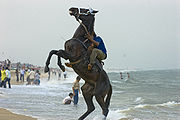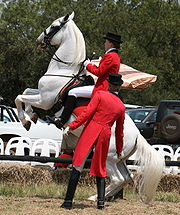
Rear (horse)
Encyclopedia




Horse
The horse is one of two extant subspecies of Equus ferus, or the wild horse. It is a single-hooved mammal belonging to the taxonomic family Equidae. The horse has evolved over the past 45 to 55 million years from a small multi-toed creature into the large, single-toed animal of today...
or other equid
Equidae
Equidae is the taxonomic family of horses and related animals, including the extant horses, donkeys, and zebras, and many other species known only from fossils. All extant species are in the genus Equus...
"stands up" on its hind legs with the forelegs off the ground. Rearing may be linked to fright, aggression, excitement, disobedience, or pain. It is not uncommon to see stallions rearing in the wild when they fight, while striking at their opponent with their front legs. Mares are generally more likely to kick when acting in aggression, but may rear if they need to strike at a threat in front of them.
When a horse rears around people, in most cases, it is considered a dangerous habit for riding horses, as not only can a rider fall off from a substantial height, but also because it is possible for the animal to fall over backwards, which could injure the horse, and the animal could also fall on the rider. It is therefore strongly discouraged. A horse that has a habit of rearing generally requires extensive retraining by an experienced horse trainer
Horse trainer
In horse racing, a trainer prepares a horse for races, with responsibility for exercising it, getting it race-ready and determining which races it should enter...
, and if the habit cannot be corrected, may be deemed too dangerous to ride.
A horse that rears when being handled by a human who is on the ground also presents a hazard, as it is able to strike out with its front feet and can also fall even without the weight of a rider to unbalance the animal. A rearing horse can also break away and escape from a human handler.
However, rearing also has survival value in the wild. It is a tactic that can be used to dislodge a predator that has landed on the animal's back, it is used when equids fight one another, and a horse can rear slightly to add force when striking out with its front feet. For these reasons, horses, particularly young ones, are sometimes seen rearing when loose in a pasture, particularly when playing or mock-fighting with pasturemates.
There are also a few times when rearing is considered acceptable by humans. Rearing may be taught as a trick for circus
Circus
A circus is commonly a travelling company of performers that may include clowns, acrobats, trained animals, trapeze acts, musicians, hoopers, tightrope walkers, jugglers, unicyclists and other stunt-oriented artists...
horses and the like. There are also two movements in classical dressage
Classical dressage
Classical dressage evolved from cavalry movements and training for the battlefield, and has since developed into the competitive dressage seen today...
, the Levade and the Pesade, in which the rider asks the horse to set well back on its hindquarters and raise its front legs off of the ground to varying degrees. However, horses properly trained to do any of these movements are taught to respond to very specific commands and only raise their forequarters when given the command.
Dealing with the Rearing Horse
A horse generally must stop before it can rear. Generally a rider can feel if a horse is about to rear, as the horse shifts its weight strongly to its hindquarters and begins to feel "light in the front end." When this occurs, rearing can still be prevented by a number of methods, the simplest of which is to either encourage the horse to move, either forward or to turn the horse in tight circles so that it cannot engage its hindquarters enough to rear. If the horse is allowed to stop or back up while behaving in a disobedient manner, it can more easily rear.If a horse manages to rear while under saddle, the rider has the best chance of bringing the horse back to the ground by leaning forward, keeping the reins slack and, in some cases, reaching around the neck of the horse to distribute as much weight as possible to the forehand. Once on the ground, the rider can prevent further rearing by asking the horse to move, either forward or in circles.
Causes and solutions
Rearing can be caused by fear; a horse that sees something alarming in front of it may stop and, if asked to continue forward, may rear rather than move ahead. Another fear response may come from poor riding. A rider that is particularly hard on a horse's mouth with the reinRein
Reins are items of horse tack, used to direct a horse or other animal used for riding or driving. Reins can be made of leather, nylon, metal, or other materials, and attach to a bridle via either its bit or its noseband.-Use for riding:...
s and bit may provoke a horse to rear from the pain the horse feels in its mouth. A horse may rear out of confusion because it does not understand what the rider's commands, or riding aids
Riding aids
Riding aids are the cues a rider gives to a horse to communicate what they want the animal to do. Riding aids are broken into the natural aids and the artificial aids.-Natural aids:...
mean, or because the rider is giving harsh or conflicting commands. If a rider both holds onto the horse's mouth at the same time they push the horse strongly with their legs, essentially using the "gas and the brake" at the same time, they can also provoke rearing.
In fact, trained, controlled movements such as the levade and the pesade are deliberately requested by a sophisticated form of collection
Collection (horse)
Collection is when a horse carries more weight on his hindlegs than his front legs. The horse draws the body in upon itself so that it becomes like a giant spring whose stored energy can be reclaimed for fighting or running from a predator...
where a careful, highly balanced rider asks the horse to raise its forequarters by a combination of riding aids that simultaneously gather the horse onto its hindquarters and lighten it in front.
If rearing with a rider is not clearly linked to fear, disobedience or aggression, it may be linked to pain. An equine veterinarian can examine the horse's mouth and teeth, back, and feet for possible causes. Pain may also be linked to poorly-fitted or improperly used tack
Horse tack
Tack is a term used to describe any of the various equipment and accessories worn by horses in the course of their use as domesticated animals. Saddles, stirrups, bridles, halters, reins, bits, harnesses, martingales, and breastplates are all forms of horse tack...
. A rider or saddle-fitting specialist can determine if pain is linked to a poorly fitted saddle
Saddle
A saddle is a supportive structure for a rider or other load, fastened to an animal's back by a girth. The most common type is the equestrian saddle designed for a horse, but specialized saddles have been created for camels and other creatures...
, or a broken saddle tree. The fit and severity of the bit
Bit (horse)
A bit is a type of horse tack used in equestrian activities, usually made of metal or a synthetic material, and is placed in the mouth of a horse or other equid and assists a rider in communicating with the animal. It rests on the bars of the mouth in an interdental region where there are no teeth...
can also lead to rearing.
Riders should also consider the management of the horse, especially if the animal does not have turn-out time and has too rich of a diet
Equine nutrition
Equine nutrition is the feeding of horses, ponies, mules, donkeys, and other equines. Correct and balanced nutrition is a critical component of proper horse care....
. A horse may rear due to excitement and excess energy.
For horses that rear while a person is leading them on the ground, the safest position for the handler is to be at the side of the animal so that the handler has maximum control but is still away from the front legs should the horse strike out. Leading horses with a stud chain on the halter
Halter
A halter, headcollar, or, less often, headstall, is headgear that is used to lead or tie up livestock and, occasionally, other animals; it fits behind the ears , and around the muzzle. To handle the animal, usually a lead rope or lead shank is attached...
or with a bridle
Bridle
A bridle is a piece of equipment used to direct a horse. As defined in the Oxford English Dictionary, the "bridle" includes both the headstall that holds a bit that goes in the mouth of a horse, and the reins that are attached to the bit....
offers more control if an animal rears; however, misuse of this equipment by jerking on the horse's head may also provoke rearing.

